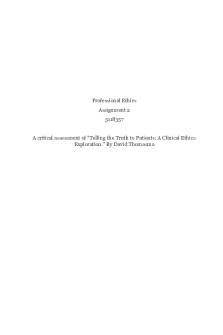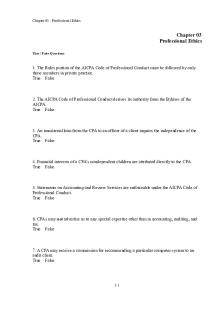Seminar 6 Professional Ethics PDF

| Title | Seminar 6 Professional Ethics |
|---|---|
| Course | Ethics in Accountancy |
| Institution | Brunel University London |
| Pages | 2 |
| File Size | 56 KB |
| File Type | |
| Total Downloads | 110 |
| Total Views | 152 |
Summary
seminar questions...
Description
Seminar 6: Professional Ethics
Case study 1: In 2006, the Securities and Exchange Commission (SEC) charged three KPMG auditors with altering audit work papers. The work papers were changed after the fact to make appear as if KPMG had properly performed the audit. Modifications included adding comments to work papers, backdating documents, and creating audit documentation after the fact. The investigation showed that the audit team spent more than 500 hours altering more than 350 working papers. Auditing standards require an auditor to complete the work of the audit before the audit opinion is issued. Critical areas on Tenet’s financial statements had not been completed before the opinion was issued, and the information in the critical areas proved to be important to the accuracy pf the financial statements. KPMG changed the audit work papers to make it appear that had done the work during the audit and had decided that changes to the financial statements were not needed.
Required: a. Describe the technical proficiency and ethical sensibility required of the auditor in this case. Did the auditor meet these requirements? b. Identify specific sections of the code of conduct that apply in this situation. c. Why did the auditor think it would be better to have made the wrong decision about whether a critical area required changes in the financial statements rather than decide to issue the audit opinion without finishing the audit work? Are both decisions violations of the standards?
Case study 2: James Gansman, an Ernst & Young partner, met a friend Donna Murdoch at Ashleymadison.com, a website for people in search of extramarital affairs. At the time Gansman advised companies involved in mergers how to combine workforce. Gansman began sharing confidential information with Murdoch about upcoming mergers of Ernst & Young clients. Murdoch did not have the money to invest in stock so he might benefit from this information, but she met another man on Ashleymadison.com, Richard Hansen, who was willing to lend her money to purchase stock for the companies about to merge. Eventually Gansman also contributed part of his bonus so she could purchase stock in the merging companies. Between November 2005 and September 2007, Murdoch traded on at least 18 Ernst & Young deals, making about £400,000 from the transactions. Early in 2007, Murdoch’s name began to appear on SEC watch lists for suspicious trading around mergers. Gansman was convicted of six counts of securities fraud. He never made a cent from the transactions, but is expected to spend three to five years in prison for his crimes.
Required: a. What is the problem both from an accounting and an ethical point of view? b. Describe the technical proficiency and ethical sensibility required of Gansman in this case. Did the meet these requirements? c. If Gansman did not benefit financially from the transactions, why should he be held accountable? d. Why is insider trading an ethical problem for the professional accountant?...
Similar Free PDFs

Seminar 6 Professional Ethics
- 2 Pages

Seminar 6 Professional Ethics
- 2 Pages

Professional Ethics for Lawyers
- 68 Pages

Professional Ethics Assignment 2
- 8 Pages

Professional responsibility and Ethics
- 165 Pages

Professional Ethics Complete notes
- 41 Pages

Professional Ethics for Lawyers
- 68 Pages

GE6075 professional ethics
- 89 Pages

Chapter 3 professional ethics
- 34 Pages

340909679 Professional Ethics Notes
- 102 Pages

Professional Ethics for Lawyers-1
- 68 Pages

Core duties in Professional Ethics
- 16 Pages
Popular Institutions
- Tinajero National High School - Annex
- Politeknik Caltex Riau
- Yokohama City University
- SGT University
- University of Al-Qadisiyah
- Divine Word College of Vigan
- Techniek College Rotterdam
- Universidade de Santiago
- Universiti Teknologi MARA Cawangan Johor Kampus Pasir Gudang
- Poltekkes Kemenkes Yogyakarta
- Baguio City National High School
- Colegio san marcos
- preparatoria uno
- Centro de Bachillerato Tecnológico Industrial y de Servicios No. 107
- Dalian Maritime University
- Quang Trung Secondary School
- Colegio Tecnológico en Informática
- Corporación Regional de Educación Superior
- Grupo CEDVA
- Dar Al Uloom University
- Centro de Estudios Preuniversitarios de la Universidad Nacional de Ingeniería
- 上智大学
- Aakash International School, Nuna Majara
- San Felipe Neri Catholic School
- Kang Chiao International School - New Taipei City
- Misamis Occidental National High School
- Institución Educativa Escuela Normal Juan Ladrilleros
- Kolehiyo ng Pantukan
- Batanes State College
- Instituto Continental
- Sekolah Menengah Kejuruan Kesehatan Kaltara (Tarakan)
- Colegio de La Inmaculada Concepcion - Cebu



